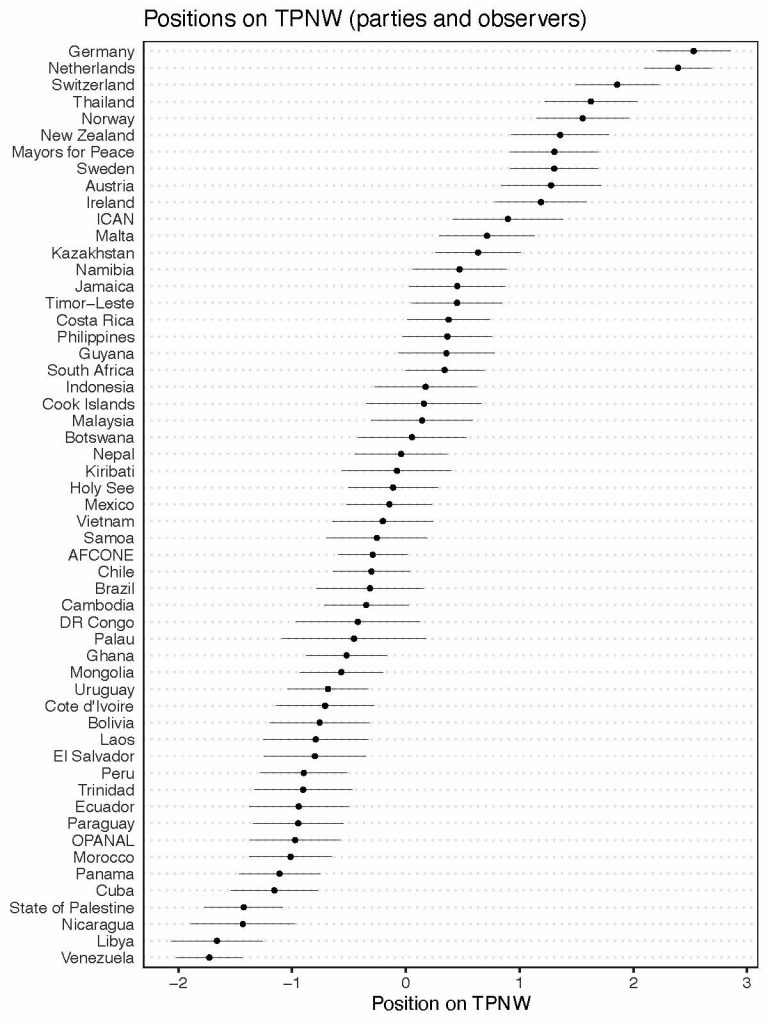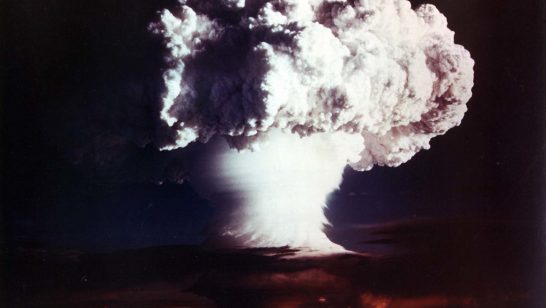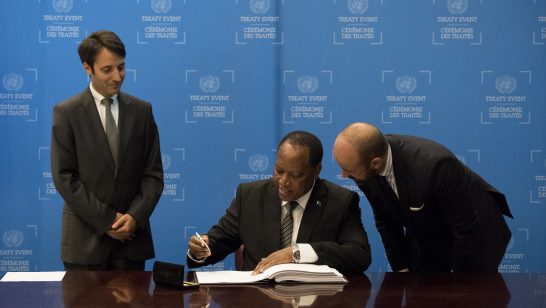
This week the Tenth Review Conference of the Nuclear Non-Proliferation Treaty will begin in New York. An emerging narrative argues that the Treaty on Prohibition of Nuclear Weapons (TPNW), also known as the Nuclear Ban Treaty, will be one of the fracture points. Such narrative might lead to false conclusions. By analysing the discussions at the ban treaty Meeting of States Parties last month in Vienna to find what divides – but also binds – these states, we find that the success of the conference should not lead us to assume that the community is unanimous. While it would be easy to think that the first ban treaty state party meeting was a meeting of friends, such a view is misleading.
Using a computational model, we scaled all statements made in Vienna last month and found that there are serious and real divisions among those who participated in the ban treaty meeting of States Parties – whether states or civil society organisations, whether supporters or opponents. We find that there are real differences among the participants. This should create doubts about any blanket statements about the supposed unanimity of the TPNW supporters. They also highlight the possibility for genuine diplomatic engagement with (some) TPNW states.
The first Meeting of States Parties to the nuclear ban treaty in June this year was a key moment in the genesis of humanitarian nuclear disarmament. The ban treaty itself was a novel approach to nuclear disarmament, focusing on humanitarian consequences rather than strategic considerations. The treaty, which was negotiated at the UN by over 120 nations over a period of one month in the summer of 2017, entered into force in January 2021 when 50 countries ratified it and the Meeting of States Parties this year indicates that the ban treaty is now a reality to be reckoned with. The meeting took place at a time when nuclear risks are perceived to be higher than ever in the recent past, with Russia repeatedly threatening the civilian nuclear infrastructure in Ukraine. Nuclear risks have become all too clear.
For many countries in the room, the meeting was an important moment in their struggle against the consequences of nuclear weapons. Participants heard from survivors of nuclear weapons use and testing about the horrifying consequences for both people and the environment. States where survivors live made repeated appeals to ban nuclear weapons and to right historical wrongs.
But the meeting was also important among non-state parties. In several European countries, where civil society’s focus on nuclear disarmament is particularly strong, the story of attending the ban treaty meeting became an issue debated in government coalition negotiations and in parliamentary chambers. Traditional disarmament champions such as Sweden and Finland decided to observe the conference despite not being parties early on; Germany and Norway too announced that they would attend. Other allies of the United States that rely on the NATO nuclear umbrella, such as the Netherlands and Belgium, made the decision to join at the last minute due to domestic political pressures.
A major question for the diplomats in the room became, over the period of three days, whether and how to condemn Russia’s dangerous nuclear rhetoric. Jamie Kwong, a Carnegie Endowment expert on multilateral nuclear forums, argued that “disparity (about whether to condemn Russia) became the meeting’s main point of contention”. Observing the dynamics within the ban treaty supporters is not only important because it can signal what to expect at the Review Conference in New York this month, but it is also important as it can tell us a lot about the dynamics within the ban treaty itself.
In our attempt to understand the tensions in Vienna, we turned to an algorithm called Wordfish to scale all statements made by states and civil society during the general debate at the conference (statements from a small handful of states are not available). Wordfish takes statements, analyses the distribution of words across them, and then places actors in a unidimensional space. Wordfish assumes that the use of certain words (and not others) distinguishes political actors’ locations in an ideological space.
Our results allowed us to place states along a single axis. The Left and right ends of the axis have no inherent meaning – they are just topologically on the left and right hand of your screen as you look at the distribution. On the right end of this axis were Western countries which took part in the Vienna conference as observers – Germany, the Netherlands, and Switzerland. However, clustered with them were Thailand (a party to the treaty), Norway (an observer), and New Zealand (another party to the treaty). On the left end of the axis, we found Venezuela, Libya, Nicaragua, Palestine, Cuba, and Panama. Very generally speaking, we find mainly Western countries clustering together on the “right”, but also civil society actors such as the International Coalition to Abolish Nuclear Weapons or Mayors for Peace could be found on this end. In contrast, the Latin American and African countries were found on the “left” end of the axis. We can therefore see that there was a visible difference between participants in the conference and that there is at least some geographical clustering of views presented in the meeting.

The positioning along the axis tells us which actors tend to speak more alike, but it does not tell us what it is that binds them. For this, we looked at the words which tend to be the most polarising and hence push countries towards either end of the axis. We find Russia-related words (such as “Russia” or “Russian”) the strongest in pulling actors toward the “right” end of the axis. It is in fact the most polarising word in the whole corpus of the speeches in Vienna. Other words associated with this end are “forward”, “engage”, “IAEA” or “review”. This indicates that the actors on the right end tended to be concerned with Russian actions, but also about setting the ban treaty in the broader institutional framework of the global nuclear regime – by references to the International Atomic Energy Agency, or to the NPT Review Conference, or by referring to engagement (presumably with non-parties). By contrast, the words with a strong pull on the “left” side are “Tlatelolco”, “life”, “planet”, and “serious”. These words refer back to two aspects: firstly, the link to earlier treaties establishing the nuclear weapons free zones (such as the Tlatelolco treaty in Latin America); secondly, the humanitarian concerns about nuclear weapons risks to human life.
Our findings indicate that there are real differences between the participants in the ban treaty meeting, in what their priorities are and how they perceive both the treaty and the broader nuclear world. This chips away at the narrative that there are two monoliths opposing one another – those supporting the nuclear ban and those outside that don’t. In reality, the nuclear ban supporters are much more ideologically diverse than often assumed and, while most Western observers are somewhat further away from members in their positions, they are also not very far away from the treaty members. Judging by the first Meeting of State Parties, the TPNW appears to attract a diverse group of states and civil society organisations who present genuinely divergent positions.
This chips away at the narrative that there are two monoliths opposing one another – those supporting the nuclear ban and those outside that don’t.
As the delegates to the Review Conference of the Non-proliferation Treaty begin their deliberations in New York, they will benefit from understanding that there is enough common ground to build coalitions with nuclear ban supporters, because their interests often overlap. There are numerous ban treaty members concerned with the declining security environment and worried about the health of the whole nuclear field. It would be a waste to turn the Review Conference into an ideological contest when the world today confronts grave nuclear risks that, if focused on, could help put the nuclear non-proliferation regime back on track towards success.
The opinions articulated above represent the views of the author(s) and do not necessarily reflect the position of the European Leadership Network or any of its members. The ELN’s aim is to encourage debates that will help develop Europe’s capacity to address the pressing foreign, defence, and security policy challenges of our time.
Image: Flickr, UNIS Vienna




